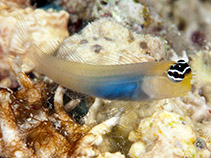| Family: |
Blenniidae (Combtooth blennies), subfamily: Salariinae |
| Max. size: |
2.43 cm SL (male/unsexed); 2.37 cm SL (female) |
| Environment: |
demersal; marine; depth range 3 - 5 m |
| Distribution: |
Western Pacific: northeastern coast of Sulawesi, Indonesia. |
| Diagnosis: |
Diagnosis: This species of the Prooculis group has a body without alternating dark and pale stripes or distinct dark spots; there is a dark stripe extending posteriorly from orbital margin across head and variably for short distance onto body anteriorly. In life, the dark post-orbital stripe is bordered ventrally by bright white stripe; other bright markings on head, white with at most a very faint tinge of yellow; belly bluish (Ref. 54476).
Description: Segmented dorsal fin rays 13-14; segmented anal fin rays 15-16; caudal vertebrae 21-22; total dentary teeth 39-45. In life, the most obvious color markings are the deep blue of the abdominal area, a vertical pair of white stripes extending through the orbit dorsal and ventral to the pupil, a pair of small white spots in the interorbital region anteriorly, and a small, mid-dorsal white spot between the dorsoposterior margins of the orbits. This dusky post-orbital spot is bordered dorsally by a fine white spot and ventrally by a fine, pale, whitish stripe that continues faintly across the head and separates the pale yellowish cheeks dorsally from the brownish color of the head dorsally. The blue of the abdomen pales posteriorly and the body becomes faintly yellow similar to the cheeks. The specimens may or may not bear evidence of broad dusky bands on the body (Ref. 54476). |
| Biology: |
This is one of the smallest species of Ecsenius, female at 2.37 cm SL having well-developed, apparently ripe, ovaries. The 1.56 cm SL male has well-developed dentary teeth, including obvious posterior canines; where in most Ecsenius species, at this size, the posterior canines are not present and the number of other dentary teeth does not appear to have been completely established (Ref. 54476). Oviparous. Eggs are demersal and adhesive (Ref. 205), and are attached to the substrate via a filamentous, adhesive pad or pedestal (Ref. 94114). Larvae are planktonic, often found in shallow, coastal waters (Ref. 94114). |
| IUCN Red List Status: |
Least Concern (LC); Date assessed: 24 March 2009 Ref. (130435)
|
| Threat to humans: |
harmless |
Source and more info: www.fishbase.org. For personal, classroom, and other internal use only. Not for publication.
